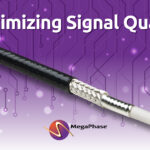High-frequency microwave applications demand robust and reliable signal transmission. When it comes to choosing the right coaxial cable, the decision between semi-rigid and flexible cables plays a vital role. In this article, we will explore the advantages and disadvantages of using semi-rigid coaxial cables in high-frequency microwave applications. We will highlight the main benefits of MegaPhase’s semi-rigid cables, including AlumiBend™ and Semi-Rigid, over flexible cables, discuss their drawbacks in terms of installation and flexibility, and provide examples of specific high-frequency microwave applications where their use is preferred.
Advantages of Semi-Rigid Coaxial Cables:
- Enhanced Electrical Performance:
MegaPhase’s AlumiBend and other semi-rigid coaxial cables offer superior electrical performance compared to flexible cables. Additionally, AlumniBend is 30% lighter than standard Semi-Rigid. With their solid aluminum outer conductor, AlumiBend cables provide exceptional shielding effectiveness, minimizing signal interference and ensuring high-quality transmission in high-frequency microwave applications.
- Improved Stability and Precision:
MegaPhase’s semi-rigid cables maintain their shape and form, even under challenging environmental conditions. This inherent stability offers improved signal integrity, precise impedance control, and minimal phase variation. These qualities make AlumiBend cables perfect choices for applications that require high levels of accuracy, such as precision testing and measurement systems.
- Higher Power Handling Capacity:
MegaPhase’s Semi-Rigid coaxial cables are designed to handle higher power levels compared to flexible cables. With the right connectors, this makes them ideal for high-power microwave applications. These cables find great utility in radar systems, satellite communications, and high-power amplifiers where reliability and power efficiency are crucial.
Drawbacks and Limitations of Semi-Rigid Coaxial Cables:
- Limited Flexibility and Bending:
One of the primary drawbacks of semi-rigid coaxial cables is their limited flexibility. They usually have a solid outer conductor, which makes them less pliable and gives them a larger bending radius compared to flexible cables. Additionally, MegaPhase provides hand-formable cables in our Conformable product line.
- Complex Installation Process:
Some semi-rigid cables require specialized tools and techniques for cutting, bending, and forming precise cable shapes. However, MegaPhase cables superior performance and long-term reliability justify the effort and allow for easier installation. MegaPhase uses a programable CNC semi-rigid bending machine, making each bend consistent, and a wide variety of hand tools.
- Less Vibration and Shock Resistance:
Due to their solid outer conductor construction, some cables may be less resistant to vibrations and shocks compared to flexible cables. In applications where mechanical stress is significant, MegaPhase’s flexible cable solutions may be more suitable.
MegaPhase’s semi-rigid coaxial cables offer unparalleled electrical performance and stability in high-frequency microwave applications. The advantages they provide, including enhanced signal transmission, accuracy, and power handling capacity, make them the preferred choice in various industries. From microwave test and measurement to RF assemblies, MegaPhase’s semi-rigid coaxial cables prove their reliability and efficiency, ensuring optimal performance in critical high-frequency microwave applications.



